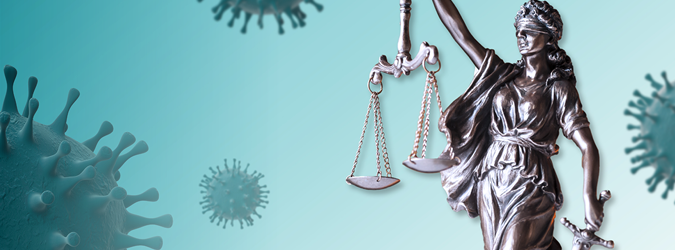How COVID-19 Has Affected the Practice of Tort Law in New York State
12.9.2021
For how long will we in the legal community be dealing with the fallout from the COVID-19 pandemic? Although the answer to this question is uncertain, the end does not appear to be in sight, especially with the detection of the Omicron variant emanating from South Africa that has already reached U.S. shores. Health care leaders are are calling this a time for caution “ but not panic.”[1] Leaders across the U.S. are heeding this call for caution, travel bans have been implemented against eight countries traveling to the U.S.,[2] and on November 26, 2021, New York Governor Kathy Hochul, declared a state of emergency. Executive Order No. 11 authorizes all state agencies “to take appropriate action to assist local governments and individuals in containing, preparing for, responding to and recovering from this state disaster emergency, to protect state and local property, and to provide such other assistance as is necessary to protect public health, welfare, and safety.”[3] This order is to remain in effect through January 15, 2022.[4]
Presently, New York is experiencing COVID-19 transmission at rates the state has not seen since April 2020; further, the rate of new COVID-19 hospital admissions has increased over the past month to more than 300 new admissions a day.[5] The consequences of the COVID-19 pandemic and its related shutdowns (which began on January 31, 2020, when a public health emergency was declared for the entire U.S.),[6] continue to be felt throughout the legal community, across each discipline. However, this article will narrow its focus to tort practitioners in New York State.
As a result of the COVID-19 pandemic, there have been various issues that both plaintiff and defendant tort practitioners have confronted, as they relate to important statutory time periods, immunity, and/or limitation of liability. What follows is a discussion of these issues, which will hopefully be beneficial to the members of NYSBA.
Executive Order 202.8
First and foremost, it is important to understand Governor Cuomo’s Executive Order 202.8, issued on March 20, 2020, which suspended and tolled the statute of limitations and various other time limits under the Procedural Laws of the State of New York.[7] This executive order was extended for 30 days three subsequent times, by further executive orders, with the tolling period ceasing on November 3, 2020. The cessation of the tolling periods was contained in Executive Order 202.67, signed by Governor Cuomo on October 4, 2020. Additionally, on November 3, 2020, Governor Cuomo confirmed that the tolling period would no longer be in effect beginning November 4, 2020, with the issuance of Executive Order 202.72.[8]
Legislative Action
The New York State Legislature then passed a bill in March 2021 that revoked the immunities enjoyed from lawsuits against hospitals, nursing homes, health care centers, health care providers and most other health care workers. That legislation passed the Legislature almost unanimously and was signed by Governor Cuomo on April 6, 2021, effectively repealing Executive Order 202.10, which had granted the above mentioned entities immunities from tort liability.[9] This legislation, Assembly Bill A03397, did not state whether it is to be applied retroactively, or to injuries that occurred in the year after the governor’s Executive Order 202.8 but had not yet been the subject of a lawsuit. Nor is there anything in the legislative history that definitively makes the bill retroactive.[10] In this regard, the Supreme Court, Appellate Division, Second Department, found in People v. Dyshawn B., 196 A.D.3d 638, 152 N.Y.S.3d 131, that:
“[T]wo axioms of statutory interpretation’ are relevant in determining whether a statute should be given retroactive effect (Matter of Gleason [Michael Vee, Ltd.], 96 N.Y.2d 117, 122, 726 N.Y.S.2d 45, 749 N.E.2d 724; see Nelson v. HSBC Bank USA, 87 A.D.3d 995, 997, 929 N.Y.S.2d 259). “Amendments are presumed to have prospective application unless the Legislature’s preference for retroactivity is explicitly stated or clearly indicated” (Matter of Gleason [Michael Vee, Ltd.], 96 N.Y.2d at 122, 726 N.Y.S.2d 45, 749 N.E.2d 724; see Majewski v. Broadalbin–Perth Cent. School Dist., 91 N.Y.2d 577, 584, 673 N.Y.S.2d 966, 696 N.E.2d 978; Matter of OnBank & Trust Co., 90 N.Y.2d 725, 730, 665 N.Y.S.2d 389, 688 N.E.2d 245; People v. Duggins, 192 A.D.3d 191, 140 N.Y.S.3d 317). However, “remedial legislation should be given retroactive effect in order to effectuate its beneficial purpose” (Matter of Gleason [Michael Vee, Ltd.], 96 N.Y.2d at 122, 726 N.Y.S.2d 45, 749 N.E.2d 724; see Majewski v. Broadalbin–Perth Cent. School Dist., 91 N.Y.2d at 584, 673 N.Y.S.2d 966, 696 N.E.2d 978; Matter of OnBank & Trust Co., 90 N.Y.2d at 730, 665 N.Y.S.2d 389, 688 N.E.2d 245; People v. Duggins, 192 A.D.3d 191, 140 N.Y.S.3d 317). “Remedial statutes are those designed to correct imperfections in prior law, by generally giving relief to the aggrieved party” (Nelson v. HSBC Bank USA, 87 A.D.3d at 998, 929 N.Y.S.2d 259 [internal quotation marks omitted]). While these principles serve as guides, ultimately, the court must attempt to discern the legislative intent either from the particular words used or, barring that, from the nature of the legislation (see Matter of Regina Metro. Co., LLC v. New York State Div. of Hous. & Community Renewal, 35 N.Y.3d 332, 370, 130 N.Y.S.3d 759, 154 N.E.3d 972; Brothers v. Florence, 95 N.Y.2d 290, 299, 716 N.Y.S.2d 367, 739 N.E.2d 733; Matter of OnBank & Trust Co., 90 N.Y.2d at 730, 665 N.Y.S.2d 389, 688 N.E.2d 245).”[11]
Consequently, it cannot be deemed to be retroactive. Thus, we believe that the legislation should be interpreted to allow lawsuits only when the injury occurred after April 6, 2021, the effective date of the bill. Whether this legislation strips away all tort immunities that were covered by Executive Order 202.8, and with respect to the important issue of whether it provides for a toll of the affected time limits (or a suspension thereof), will ultimately be decided by the courts. Indeed, the NYSBA CPLR Committee had previously decided to recommend that the Legislature enact an amendment to CPLR 218 to add a new paragraph “C,” which would provide that Governor Cuomo’s executive orders “shall be considered a toll and not be part of the time within which any action must be commenced, or other prescribed act taken.” That proposal was approved by NYSBA’s Executive Committee and has been discussed by the appropriate committees of the Legislature. However, even with lobbying by NYSBA, the amendment to CPLR 218 has not been approved by the Legislature.
Brash v. Richards
In the interim, the courts, as anticipated, have started to weigh in on this important issue. On June 2, 2021, the Supreme Court, Appellate Division, Second Department, held that the governor’s executive orders must be interpreted to mean that the statute of limitations and other time periods involved are tolled, and therefore, suspended. This means that statutes of limitations that were in place during this time ceased to run for the duration of the toll. These time limits resumed when the period of the toll ended.[12] The court noted that Governor Cuomo’s March 20, 2020 Executive Order, “expressly and plainly provided that the subject time limits were ‘hereby tolled,’ and two of the subsequent executive orders referred to the temporary alternation of the subject time limits as a ‘toll.’”[13] Although the governor’s subsequent executive orders did not expressly use the word “toll,” the court reasoned that:
“those executive orders all either stated that the Governor “hereby continue[s] the suspensions, and modifications of law, and any directives, not superseded by a subsequent directive,” made in the prior executive orders (Executive Order [A. Cuomo] Nos. 202.14, 202.28, 202.38, 202.48 [9 NYCRR 8.202.14, 8.202.28, 8.202.38, 8.202.48]) or contained nearly identical language to that effect (see Executive Order [A. Cuomo] Nos. 202.55, 202.55.1, 202.60 [9 NYCRR 8.202.55, 8.202.55.1, 8.202.60]). Since the tolling of a time limitation contained in a statute constitutes a modification of the requirements of such statute within the meaning of Executive Law § 29–a(2)(d), these subsequent executive orders continued the toll that was put in place by Executive Order (A. Cuomo) No. 202.8 (9 NYCRR 8.202.8).”[14]
The Second Department, therefore, explicitly interpreted the language of the executive order as a toll. Thus, the days during which the executive orders were in effect do not count in determining statutory time periods. As stated above, time periods ceased running the day Executive Order 202.8 was signed, March 7, 2020, and did not begin to resume until the expiration of the order and its subsequent extensions on November 3, 2020.[15] Alternatively, if the court determined that the executive order merely suspended the statutory period, the time period would simply be delayed until the end date of the suspension.
The tolling of statutory time limits made a great deal of sense considering the circumstances of the COVID-19 pandemic, which has lasted almost two years. When the executive orders were enacted, no one knew when the shutdown would come to an end. Not only were the courts basically shut down, but nearly all aspects of everyday life came to a halt for an extended period of time. Under these circumstances, litigants would be extremely disadvantaged if the statutory period continued to run.[16] Statutory periods of limitations furnish complainants with the necessary opportunity and time to pursue, investigate, and discover legal claims. The claimant’s ability to meaningfully prepare for litigation was significantly impaired by the COVID-19 pandemic’s resulting shutdowns. During this time, it was fair and reasonable for statutes of limitations to be tolled, in order to prevent individual’s legal rights from being impaired as a result of the disruptions caused by the pandemic.[17] In addition to the Appellate Division, Second Department case referred to above, several lower courts throughout the state have since addressed the issue and held that Executive Order 202.8 and its subsequent provisions tolled the statutes of limitations.[18]
Although at least one lower court held that the governor lacked the power to toll statutes of limitations, and that the executive order resulted in a suspension rather than a toll,[19] this case was essentially overturned by the Second Department’s decision in Brash. The prevailing view is to treat the governor’s executive order as a toll; however, there are some areas where the toll may not apply:
(1) The tolling language does not appear to include the time to serve an answer to a complaint, though this may have been an oversight and not an intentional exception.[20]
(2) The toll does not apply to the time to serve answering papers to a motion.[21]
(3) The toll may not apply to discovery deadlines.[22]
(4) Certain election law deadlines are exempt from tolling.[23]
Nonetheless, an amendment to CPLR 218 is still necessary to protect lawyers and litigants whose COVID-19 causes of action may have accrued during the pendency of Executive Order 202.8 but have not yet been put to into suit.. In the absence of such legislation, and in spite of the recent enactment by the Legislature and signed by Governor Cuomo, such an amendment would serve to prevent judges from the around the state ruling that the executive order was not a toll, but just a suspension of the various affected time limits. This would in effect codify what the Second Department held in Brash and prevent any discrepancies among the departments. It would also make it clear as to exactly what time limits were encompassed by the executive order.
Appellate Time Limits
The court determined that the governor’s executive orders applied to the Appellate Division. As the executive order is no longer in effect, it is likely that there were or will be no more automatic extensions without a court order with respect to the 30-day requirement for filing a notice of appeal, or the number of days that a practitioner must perfect his or her appeal. Practitioners should therefore adhere to the pre-COVID-19-time limit rules as of April 6, 2021, the date the governor signed the repeal legislation.[24] Although it has been reported that all the Appellate Departments have been very liberal in granting extensions of time to perfect appeals and answer to an appellant’s briefs, despite backlogs in at least the Second and First Departments, the Court of Appeals determined that the Appellate Division, Third Department, erred in denying a pro se litigant extra time to perfect his appeal.[25]
Immunity for Health Care Workers
Shortly after the governor’s original executive order, the issue of immunity for health care workers, including employees of hospitals, nursing homes and other health care facilities, became a primary issue. It was pointed out that most health care workers who themselves become ill or are otherwise injured, would be covered under the Worker’s Compensation Law of the State of New York except in certain cases. In March 2021, the Legislature passed additional legislation that purports to provide that the indemnity protections of Public Health Law § 17 should be available for certain physicians.[26] This legislation would apply to claims pending at the time the bill was signed into law (also in April 2021). However, it should be noted that this legislation “shall apply when a claim or proceeding arises while the physician was acting on behalf of the State within the scope of such physician’s public employment or duties.”[27] Thus, this legislative provision applies to physicians only, and indeed only certain physicians who are acting on behalf of the state or within the scope of their public employment or duties.
A parallel issue that needs to be addressed is immunity from legal actions, granted by Executive Order 202.10, which protected any facility, physician or other health care worker from malpractice allegedly committed while Executive Order 202.8 was in effect.[28] This includes whether immunity should be conferred for a claim involving failure to treat individuals for other conditions because hospitals were not accepting patients during various parts of the pandemic. The two legislative acts mentioned above do not appear to directly answer that question. However, based on the following language contained in the legislation, it is submitted that the legislation must be interpreted broadly:
“The immunity provided by subdivision one of this section shall not apply if the harm or damages were caused by an act or omission constituting willful or intentional criminal misconduct, gross negligence, reckless misconduct, or intentional infliction of harm by the health care facility or health care professional providing health care services, provided, however, that acts, omissions or decisions resulting from a resource or staffing shortage shall not be considered to be willful or intentional criminal misconduct, gross negligence, reckless misconduct, or intentional infliction of harm.”[29]
The two legislative acts mentioned above do not appear to directly answer that question and we believe that it needs to be clarified.. Consistent with the recommendations that the new law passed by the Legislature stripping many immunities be interpreted as not to be retroactive the Executive Order 202.10 should be likewise interpreted to protect against malpractice actions where the causes of action arose before the April 2021 legislation was enacted.
Immunities Conferred in Neighboring Jurisdictions
The final issue pertaining to tort practice that must be addressed are actions taken by neighboring states. In Pennsylvania, a broad tort immunity bill was passed in November 2020, only to be vetoed by its governor.[30] The New Jersey Legislature has at the same time introduced several bills that would have rescinded protections previously provided in a March 2020 enactment.[31] These bills to rescind were not enacted and the broad protections contained in the prior bill remained in effect throughout the state of emergency. Conversely, Florida has codified immunity from litigation, as a result of COVID-19, allowing business entities, educational institutions, government entities, and religious institutions to “enjoy heightened legal protections against liability”; however, this law failed to extend such protections to health care workers.[32]
Moreover, our neighboring states must analyze the broad implications surrounding COVID-19 emergency orders. An important ruling from the Massachusetts Supreme Judicial Court, decided on September 3, 2021, suggests that the tolling of statutory filing deadlines in civil suits could affect litigation in that state over the next six years.[33] Here, the issue involved a claimant who on September 24, 2020, commenced a personal injury action regarding an incident which occurred on September 3, 2017, after the expiration of the three-year filing period for tort actions. The question was whether she could take advantage of the state’s emergency order tolling this period from March 17, 2020, through June 30, 2020, due to the COVID-19 pandemic.[34] The court emphasized the plain language of the statute which unambiguously tolled “all civil suit actions.”[35] Consequently, the justices rejected the defendant’s argument that the emergency order should only apply to civil actions that expired within that three-month period; instead, the court held that the tolling provision simply meant that the claimant had approximately 100 more days to file. The Massachusetts decision acknowledges the unique challenges that face plaintiff’s attorneys amidst a global pandemic. Commencing tort litigation requires adequate preparation in advance of filing, including interviewing witnesses and obtaining medical records, which was highly impracticable during the height of the COVID-19, and continues to remain a challenge.
Conclusion
It will be interesting to follow how our courts, and those of our neighbors, rule on the many COVID-19 related cases already in the pipeline and yet to be decided. Absent further action by the New York State Legislature, and from the legislature in neighboring jurisdictions, it will be up to the courts to rule on policy issues raised by many types of civil lawsuits.
Craig Purcell is partner at Glynn, Mercep, and Purcell. He is the Co-Chair of NYSBA’s Task Force on COVID-19, has served on the House of Delegates for over 20 years and was a member of the Executive Committee for three years. He is the immediate past Co-Chair of the Commission on the Tort System and was Chairman of the New York State Conference of Bar Leaders from 1998-1999. Purcell is a past president of the Suffolk County Bar Association and has been a guest lecturer at Touro Law Center and Hofstra University’s School of Law, and frequently lectures for the Academy of Law of the SCBA.
Shannon Lynn Malone is an associate at Glynn, Mercep, and Purcell. She is currently awaiting admission to the New York state bar after successfully passing the bar exam in July 2021. She graduated third in her class from Touro Law Center, where she worked as a notes editor for the Touro Law Review and earned CALI Awards for Academic Excellence in Torts, Criminal Law, Legal Process I, and Legal Process II.
[1] Melina Delkic & Giulia Heyward, Governors Urge Caution in the United States on the Omicron Variant, Nov. 28, 2021, (accessible at: https://www.nytimes.com/2021/11/28/us/governors-omicron-covid.html).
[2] On Monday, November 29, 2021, President Biden implemented travel bans against Botswana, Eswatini, Lesotho,
Malawi, Mozambique, Namibia, South Africa, and Zimbabwe. See, https://www.npr.org/2021/11/29/1059772335/us-restricts-international-travel-over-omicron-variant.
[3] N.Y. Exec. Order No. 11 (Nov. 26, 2021), https://www.governor.ny.gov/executive-order/no-11-declaring-disaster-emergency-state-new-york
[4] Id.
[5] Id.
[6] Id.
[7] N.Y. Exec. Order No. 202.8 (Mar. 20, 2020), https://nycourts.gov/whatsnew/pdf/EO-202.8-ocr.pdf.
[8] N.Y. Exec. Order No. 202.72 (Nov. 3, 2020), https://www.governor.ny.gov/sites/default/files/atoms/files/EO%20202.72%20new.pdf.
[9] The legislation was introduced on January 26, 2021, and signed into law on April 6, 2021. See, N.Y. Assemb. B. A03397. Reg. Sess. 2021-2022 (2021), https://www.nysenate.gov/legislation/bills/2021/a3397.
[10] Id.
[11] People v. Dyshawn B., 196 A.D.3d 638, 152 N.Y.S.3d 131, 132–33 (2021).
[12] See, Brash v. Richards, 195 A.D.3d 582, 149 N.Y.S.3d 560, 563 (2021).
[13] Id.; See, N.Y. Exec. Order Nos. 202.67, 202.72 [9 NYCRR 8.202.67, 8.202.72]; see also, Foy v. State of New York, 71 Misc.3d 605, 144 N.Y.S.3d 285; Kugel v. Broadway 280 Park Fee LLC, Jan. 28, 2021, at 17, col 2, 2021 NYLJ LEXIS 25 [Sup Ct, N.Y. County].
[14] Brash v. Richards, 195 A.D.3d 582, 149 N.Y.S.3d 560, 563 (2021).
[15] See, N.Y. Exec. Order No. 202.72, supra note 2.
[16] Thomas A. Moore & Matthew Gaier, Update on COVID-19 Issues, N.Y.L.J. (May 28, 2021), accessible at https://www.law.com/newyorklawjournal/2021/05/28/update-on-covid-19-issues/)
[17] Id.
[18] See, Bastell v. Village of Rye Brook, 2021 WL 1775002 (Table), 2021 N.Y. Slip Op. 50394(U) (Sup. Ct., Westchester Co. 2021); Matter of 701 River Street Associates, 2021 WL 1621630, 2021 N.Y. Slip Op. 21116 (Sup. Ct., Rensselaer Co. 2021); Foy v. State of New York, 71 Misc.3d 605 (Ct. Claims 2021).
[19] McLaughlin v. Snowlift Inc., 2021 WL 2173276, at *2 (Sup. Ct. Kings Co. May 20, 2021).
[20] See, D. Siegel, New York Practice § 33, cumulative supplement (6th ed.).
[21] See, § 8:8. Plaintiff’s failure to timely serve process, 2 N.Y.Prac., Com. Litig. in New York State Courts § 8:8 (5th ed.); Solomon v. Gun Hill Assocs. Tr., 143 N.Y.S.3d 813 (Sup. Ct. Bronx Co. 2021).
[22] See, D. Siegel, New York Practice § 353, cumulative supplement (6th ed.); Suppl. Practice Commentary to McKinney’s CPLR 3124.
[23] See, Echevarria v. Bd. of Elections in City of New York, 122 N.Y.S.3d 904, 905 (2d Dep’t 2020).
[24] See, N.Y. Assemb. B. A03397, supra note 3.
[25] Matter of Miller v Annucci, 2021 N.Y. Slip Op 04954 [37 NY3d 996].
[26] N.Y. Pub. Off. Law § 17.
[27] Id.
[28] N.Y. Exec. Order No. 202.10.
[29] See, Article 30-D of the Emergency or Disaster Treatment Protection Act.
[30] Molly E. Flynn & Rebecca Trela, A Year into the Pandemic, a Review of State, Federal COVID Tort Immunities, Task Force on COVID-19 Immunity and Liability (Jan. 18, 2021).
[31] Id.
[32] Husch Blackwell, 50-State Update on COVID-19 Business Liability Protections (updated: March 18, 2021), https://www.huschblackwell.com/newsandinsight/50-state-update-on-covid-19-business-liability-protections.
[33] Shaw’s Supermarkets, Inc. v. Melendez, 488 Mass. 338, 173 N.E.3d 356, 358 (2021).
[34] Id.
[35] Id. at 360.





